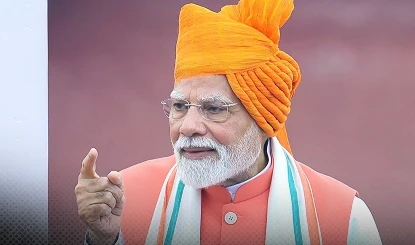In his Independence Day 2025 address from the Red Fort, Prime Minister Narendra Modi announced the ambitious Sudarshan Chakra Mission, aimed at expanding, strengthening, and modernising India’s national security shield and developing powerful indigenous weapon systems capable of neutralising enemy threats and delivering decisive counter-strikes.
Drawing inspiration from Lord Krishna on the eve of Janmashtami, PM Modi said India had chosen the path of the legendary Sudarshan Chakra—a disc-shaped celestial weapon mentioned in Hindu scriptures and traditionally associated with Lord Vishnu and his incarnation, Lord Krishna.
In modern India, the term “Sudarshan Chakra” has also inspired the armed forces. It is the nickname for the S-400 air defence missile system operated by the Indian Air Force and lends its name to the XXI Corps of the Indian Army, known as the Sudarshan Chakra Corps.
The Sudarshan Chakra Corps – India’s Western Strike Power
Headquartered in Bhopal and officially designated as XXI Corps, the Sudarshan Chakra Corps was originally raised in 1917 for World War I operations in the Middle East. It was re-raised in World War II and reorganised in 1990 to address evolving regional security threats.
Operating under the Southern Command in Pune, it is the only strike corps in this region and plays a central role in India’s military doctrine against Pakistan.
Role in Deterring and Countering Pakistan
The Corps is one of India’s primary offensive formations, structured for rapid mobilisation and deep armoured thrusts into enemy territory.
Under India’s Cold Start (Pro-Active) Doctrine, the Corps is trained to:
- Launch swift, mechanised offensives across the western front.
- Seize strategic territory quickly.
- Neutralise key military targets inside Pakistan with the support of air power.
Its large-scale air-land battle exercises, involving tens of thousands of troops, tanks, artillery, and aircraft, are frequently held near the western border to maintain readiness and signal deterrence.
Composition and Capabilities
The Sudarshan Chakra Corps comprises:
- 31 Armoured Division (“White Tiger Division”) – Jhansi-Babina
- 36 Rapid Infantry Division (“Shahbaaz Division”) – Sagar
- 54 Infantry Division (“Bison Division”) – Secunderabad
- 41 Artillery Division (“Agnibaaz Division”) – Pune
Supporting elements include armoured brigades, artillery units, infantry, air defence regiments, engineering brigades, and logistics formations.
The Corps also maintains amphibious capabilities, crucial in the context of growing China–Pakistan maritime cooperation in the Indian Ocean region. Continuous integration of cutting-edge defence technologies is enhancing its operational efficiency.
Earlier this month, Lt Gen Arvind Chauhan took charge as the 29th General Officer Commanding of the Sudarshan Chakra Corps, succeeding Lt Gen Prit Pal Singh.
With the Sudarshan Chakra Mission, PM Modi has signalled a long-term national defence strategy—rooted in indigenous capability building, inspired by India’s heritage, and focused on future battlefield readiness.


